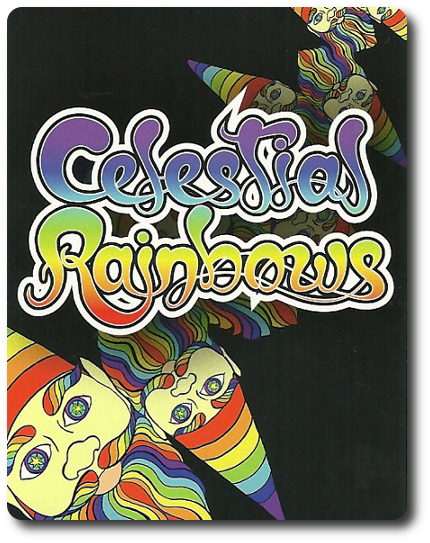
The Basics:
- For ages 4 and up (publisher suggests 8+)
- For 2 to 8 players
- Approximately 15 minutes to complete
Geek Skills:
- Active Listening & Communication
- Counting & Math
- Logical & Critical Decision Making
- Reading
- Memorization & Pattern/Color Matching
- Cooperative & Team Play
- Hand/Resource Management
Learning Curve:
- Child – Easy
- Adult – Easy
Theme & Narrative:
- Cooperatively create a rainbow with friends and family before time runs out!
Endorsements:
- Gamer Geek rejected!
- Parent Geek mixed!
- Child Geek approved!
Overview
Dorothy told us that a better world was over the rainbow and the rumor persists that a pot of gold can be found at the end of one. Rainbows have been and continue to be sources of wonder, beauty, and inspiration. Despite being nothing more than a refraction and dispersion of the sun’s light by moisture in the air, we continue to see it as more than what it is. Truthfully, seeing colors in the sky is pretty darn cool, but are rainbows magical? Of course not, but that doesn’t mean they aren’t awesome. In this game, you can create your own rainbow of magical delight with friends and family.
Celestial Rainbows, designed by Ian Brody and published by Griggling Games, is comprised of 49 single colored Rainbow cards, 1 Double Rainbow card, and 5 Magic Power cards, for a total of 55 cards. The majority of the cards are loaded with psychedelic artwork. I assure you that the game itself has nothing to do with LSD, mescaline, psilocybin, or dimethyltryptamine despite the images strongly suggesting the contrary.
The game’s artist, Aurora, is a self-described “walk-in”, which according to her, is “a person who has come to newly inhabit the physical body of a person who has recently died (or relinquished their life)”. She has been occupying her current body since 2001 after the original occupant suffered traumatic head injury. She also claims to be an alien/hybrid, have a collection of spirit friends she is in constant telepathic connection with, and has a message for Earth (presumably from outer space or another dimension). Really, I’m not making this stuff up. To learn more about this unique individual and her artwork, visit her FAQ or her main website.
Game Set Up
To set up the game, first find and separate the 5 Magic Power cards. The Magic Power cards depict one of the most trippy-hippy garden gnomes I have ever seen.
Second, shuffle the remaining cards and deal 2 to each player face-down and 2 face-up. The cards that are dealt face-up are left on the table, with the other 2 cards held by the player and kept secret.
Third, take the 5 Magic Power cards and shuffle them back in with the rest of the cards. Place this deck of cards in the middle of the playing area.
This completes the game set up. Time to get groovy.
Building Rainbows
Before I get into how to play the game, I need to explain how a rainbow is built. Each Rainbow card has one side that is a solid colored “wedge” that is either red, orange, yellow, green, blue, indigo, or violet. The sizes of the “wedges” go from large to small. When building a rainbow, the Rainbow cards should be placed so that the “wedges” create a cone-like shape from largest colored “wedge” to the smallest colored “wedge”.
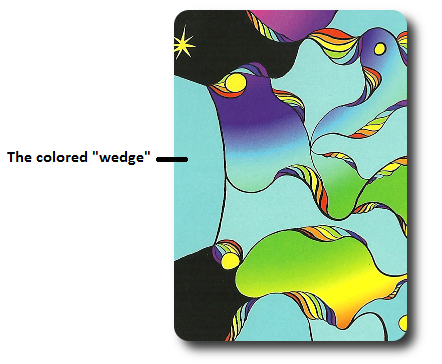
Only 1 rainbow can be built by the players at a time and must start with red and end with violet. The Double Rainbow card represents any of the 7 colors.
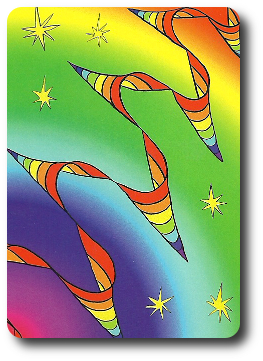
Tripping Rainbows
This is a cooperative game, which means players should be working together. They can talk to each other about strategy, but cannot tell other players what their face-down cards are.
The game is played in turns with no set number of turns per game. On a player’s turn, they take 1 of 4 optional actions and 1 required action. A player’s turn is summarized here.
Optional Action 1: Build the Rainbow
The player can add a maximum of 2 cards to start or add to an existing rainbow. Rainbows must start with a red Rainbow card, be built in color order, and end with violet. Any and all cards played to a Rainbow must be face-up prior to being added. The player then draws 1 card from the draw deck to replace each card they played. If a Magic Power card is drawn, place it immediately in the middle of the playing area and draw 1 additional card. This card is added to the Magic Power card’s row. Then the player should draw another card to replace the cards played.
Optional Action 2: Swap Cards
The player has two choices when it comes to swapping cards.
- Swap two face-down cards belonging to any player or in a row next to a Magic Power card
- Swap one of their face-down cards with any player’s face-up card
The intent here is to setup cards for other players and reveal hidden cards. Remember, rainbows must start with a “red’ Rainbow card or a Double Rainbow card.
Optional Action 3: Discard and Draw a Card
If the player cannot play a card and chooses not to swap, they must discard one of their held cards and draw another card to replace it. Discarded cards are placed in a discard pile next to the draw deck. This ends the player’s turn. If a Magic Power card is drawn, place it immediately in the middle of the playing area and draw 1 additional card. This card is added to the Magic Power card’s row.
Optional Action 4: Play to Magic Power Cards
The Magic Power cards are a double-edge sword. When they come into play, they remove cards from play by attaching Rainbow cards to it. If any Magic Power card has 7 Rainbow cards attached to it (the colors of the cards doesn’t matter), the Rainbow cards attached to it and underneath it are removed from the game, along with the Magic Power. As such, Magic Power cards greatly reduce the odds of the players completing rainbows since there are only so many Rainbow cards of each color (7 of each, to be exact).
But there is an upside.
Magic Power cards can also provide the players with a special ability, referred to as “Good Karma”. If a player plays a Rainbow card to a Magic Power card that already has that color, both colors are placed UNDERNEATH the Magic Power card. If a Magic Power card ever has all of the cards attached to it placed UNDERNEATH it, the Rainbow cards underneath are shuffled back in to the draw deck. The Magic Power card is given to the players to use. The Magic Power can only be used once per game, and once used, is discarded. Magic powers include swapping cards from your hand for cards that have been removed from play, taking an additional action, and ignoring standard rules.
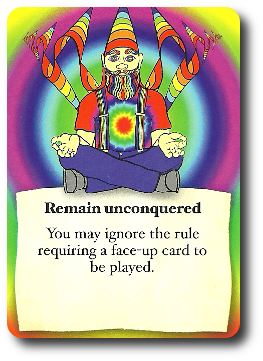
Required Action: Add to the Magic Powers
The last action the player must take is draw 1 card from the draw deck for each Magic Power card in play, adding it to the Magic Power card’s row. If the Magic Power card was just drawn during the optional actions 1 or 3, it still gets a card during this required action.
Completing Rainbows and Endgame
A rainbow is completed when the seventh and final color, violet, is played to it. The rainbow is then collected and set aside. It will be scored later in the game. A new rainbow can now be built starting with red.
The endgame is triggered when the last card from the draw deck is taken by a player. Each player now gets 2 additional full turns (including the player who drew the last card). When all the players have completed their final 2 turns, the number of rainbows scored are counted. The goal is to get as many completed rainbows as possible, the maximum number being 7 (which means the players are total bosses) and the minimum being 0 (which means the players need to play another game).
Game Variant
For an easier game, play with 3 cards face-up instead of 2.
To learn more about Celestial Rainbows, visit the game’s web page.
Prediction
Simple card games that can be played with the whole family are almost always well received. Especially those that do not require a great deal of time to set up or explain. Add in cooperative game play, and we might have ourselves a winner.
Emphasis on the “might”.
Celestial Rainbows is difficult to look at. The colorful swirls are very abstract and tend to dominate the cards when all that is necessary to focus on is the colored wedge. For the colorblind (or easily distracted), Celestial Rainbows is not a game that can be played. Add in the difficulty of determining what color should be played next that is made even more difficult without a guide or reference card to assist players, and this seemingly simple cooperative card game might feel unnecessarily complicated.
I imagine the Child Geeks will approve the card game, as they like playing games with the family where the entire family works together. So do the Parent Geeks, but I think we’ll see a mixed result from them based on the game’s visual color scheme and oftentimes perplexing color set order. I don’t see why the Gamer Geeks would approve Celestial Rainbows, as it is way too open of a cooperative game that can easily be won if everyone at the table simply communicates.
Teaching Celestial Rainbows is best done by completing a quick demonstration and talking through the first two rounds of play. I also suggest you create some sort of reference card that everyone at the table can look at. This will help players organize their cards which is essential to winning the game. Note that Celestial Rainbows does not require a lot of reading other than the Magic Power cards, which can be read by any player. This allows young Child Geeks who cannot read to enjoy the game with the family. The only real requirements to play the game is being able to see colors and a willingness to work with others.
And so, after teaching the game to my 3 little geeks, I asked them their thoughts on the game so far.
“The colors on these cards are crazy.” ~ Liam (age 9)
“Is that a garden gnome, Daddy?” ~ Nyhus (age 6)
“Pretty!” ~ Ronan (age 4)
None of my little geeks had any questions about how the card game was played, but they had a lot of questions about the artwork, the artist, and if they could make a tie-dye shirt in the near future. Let’s play the game and see if it’s as fun as it’s colorful.
Final Word
The Child Geeks liked playing the game with their family. The most enjoyable aspect of the game was the cooperative effort it took to create rainbows. This allowed even our youngest Child Geeks to participate, if not play the game fully by themselves. Because everyone is working together, the mood at the family gaming table is always one of solidarity. According to one Child Geek, “I like this game because you get to work together to create beautiful things.” A very pleasant sentiment and one that was shared by the majority of the Child Geeks. One Child Geek said, “This game is OK. I like how we get to work together and have to organize our cards, but I don’t think I would want to play this a lot. It hurts my eyes.” When all the games were over, the Child Geek majority voted to approve Celestial Rainbows.
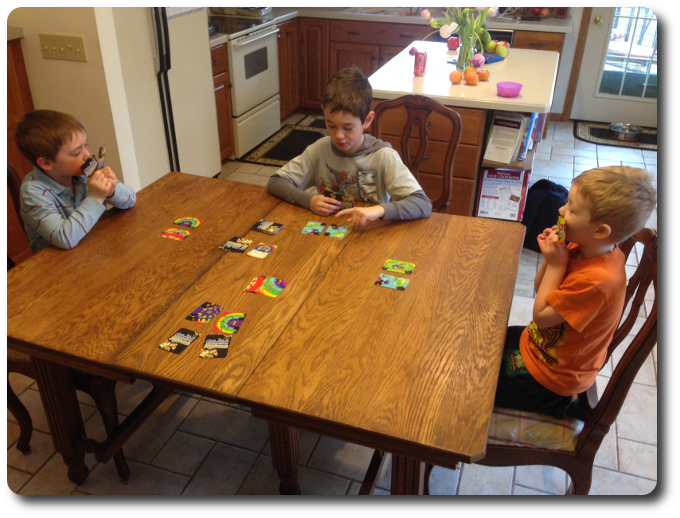
My little geeks talk through their moves and work together to create a beautiful rainbow
Some of the Parent Geeks very much enjoyed Celestial Rainbows and some did not. The number one factor that determined if the Parent Geek liked the game was knowing what color came next. According to on Parent Geek, “I understand that the colors need to be played in order, but that doesn’t mean I know which color to play next.” Another Parent Geek said, “What this game needs is a player reference card that shows the colors in the proper order.” Some of the Parent Geeks also suggested a number on the cards to help the colorblind play, as well. In the end, the Parent Geek vote was mixed. Some enjoyed the game enough to give it their approval, finding Celestial Rainbows to be a fun cooperative card game, while others found the game to be forgettable and poorly designed.
The Gamer Geeks didn’t care for the game. They found the cooperative nature of Celestial Rainbows to be unnecessarily busy. According to one Gamer Geek, “I don’t know why you have to hide cards. It seems like a rule that was put in place to make the game unnecessarily more complicated and longer than it should be.” Another Gamer Geek said, “I think this game needs a bit more work. The artwork is way too busy, but the game’s fundamental game play is pretty good. I like how the table has to switch and swap to time rainbow builds.” When the votes came in, the Gamer Geeks voted to reject Celestial Rainbows.
While I enjoyed the cooperative aspect of the game and found it entertaining to prep rainbow builds by swapping cards with my fellow game players, the colors and artwork on the cards were a real sore point. The cards are way too busy and I found the color schemes, swirls, and twisting lines to be noise detracting from the goal of the game and ease of play. There were many times that I observed players picking up cards, holding them closer to their faces, and even comparing colored wedge sizes to determine if the color being placed was the next one in order. I fixed this by adding a small letter to each card (A through G). This helped a great deal and all our games after adding the letter were much smoother and more enjoyable. Even the players who had a hard time with colors had zero issue after the letters were added.
Obligatory “Double Rainbow” YouTube clip now follows.
This game was given to Father Geek as a review copy. Father Geek was not paid, bribed, wined, dined, or threatened in vain hopes of influencing this review. Such is the statuesque and legendary integrity of Father Geek.



